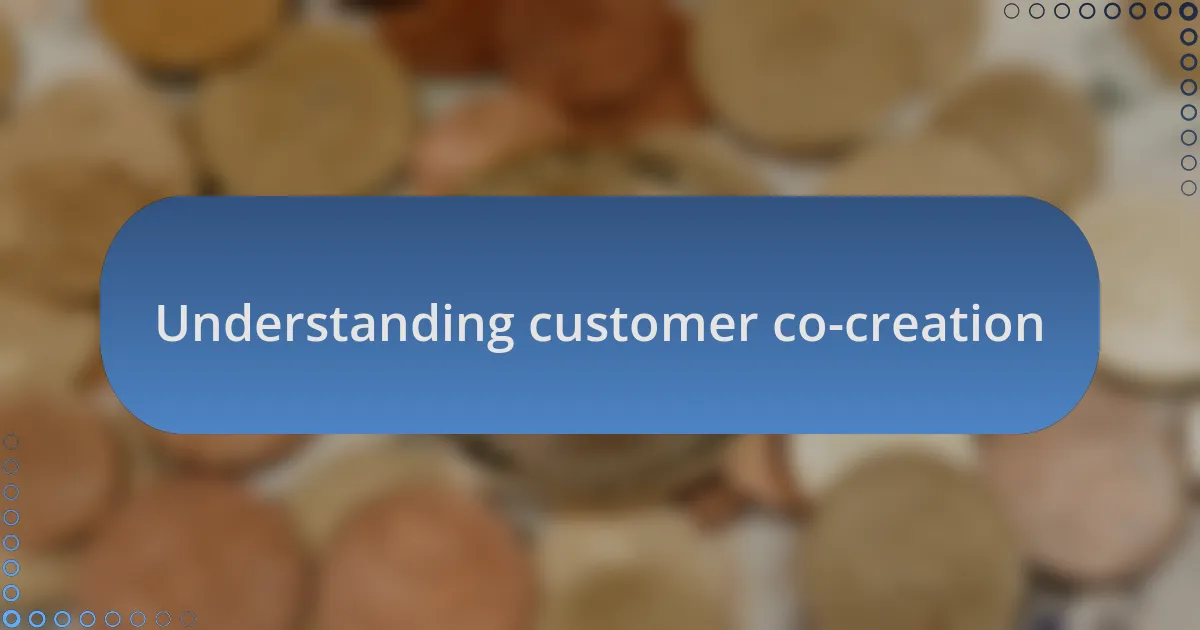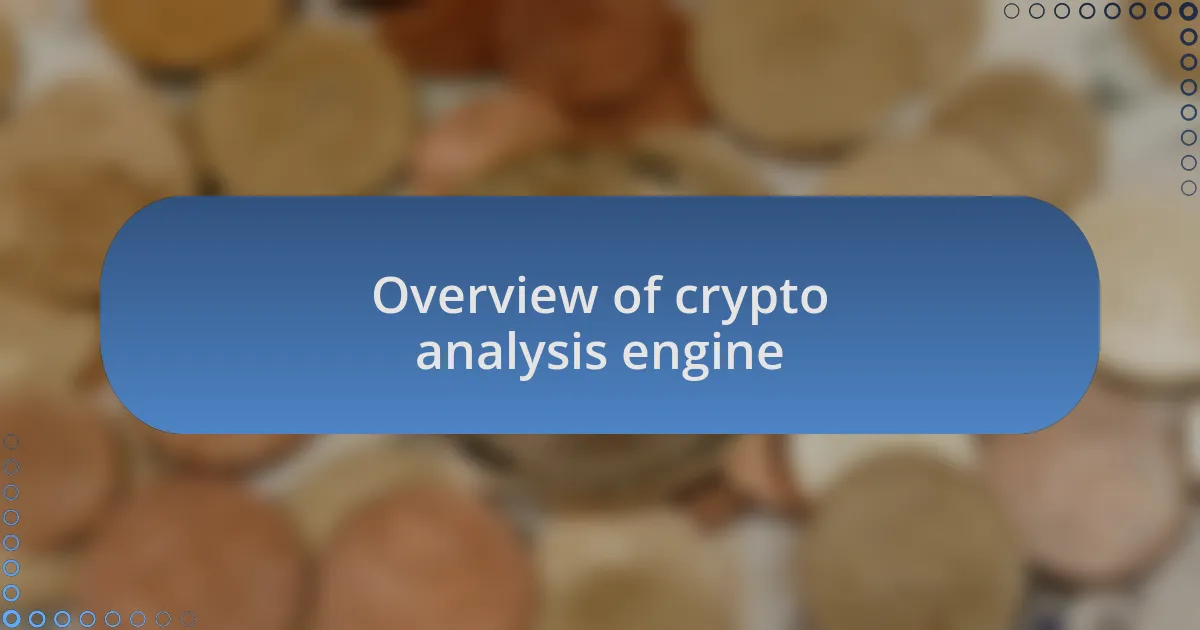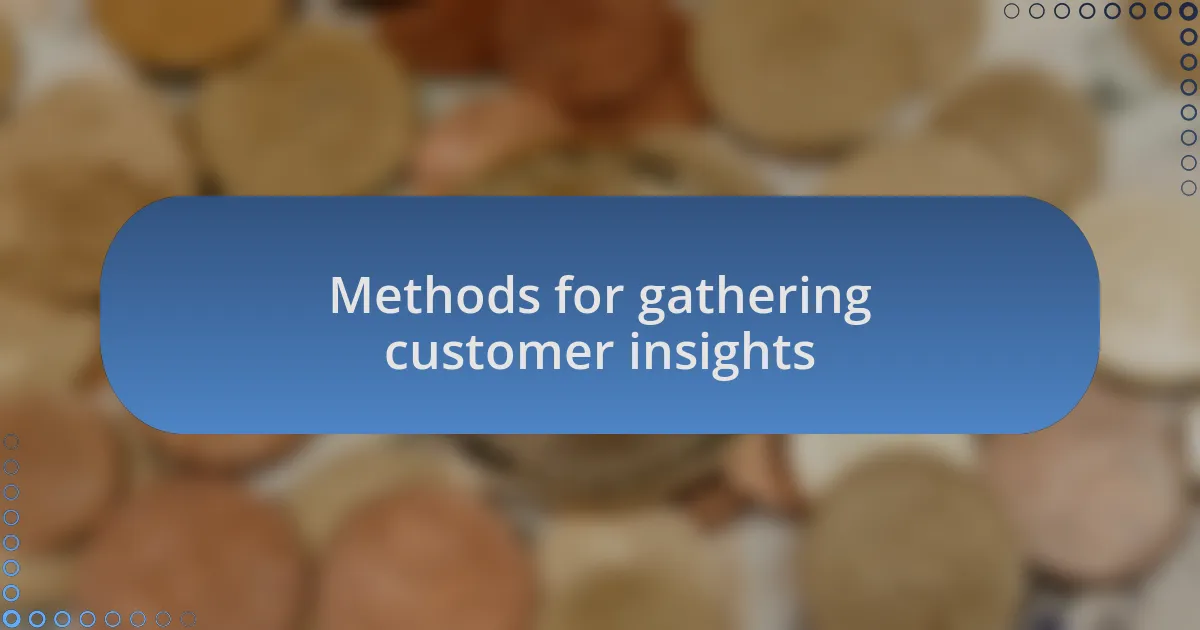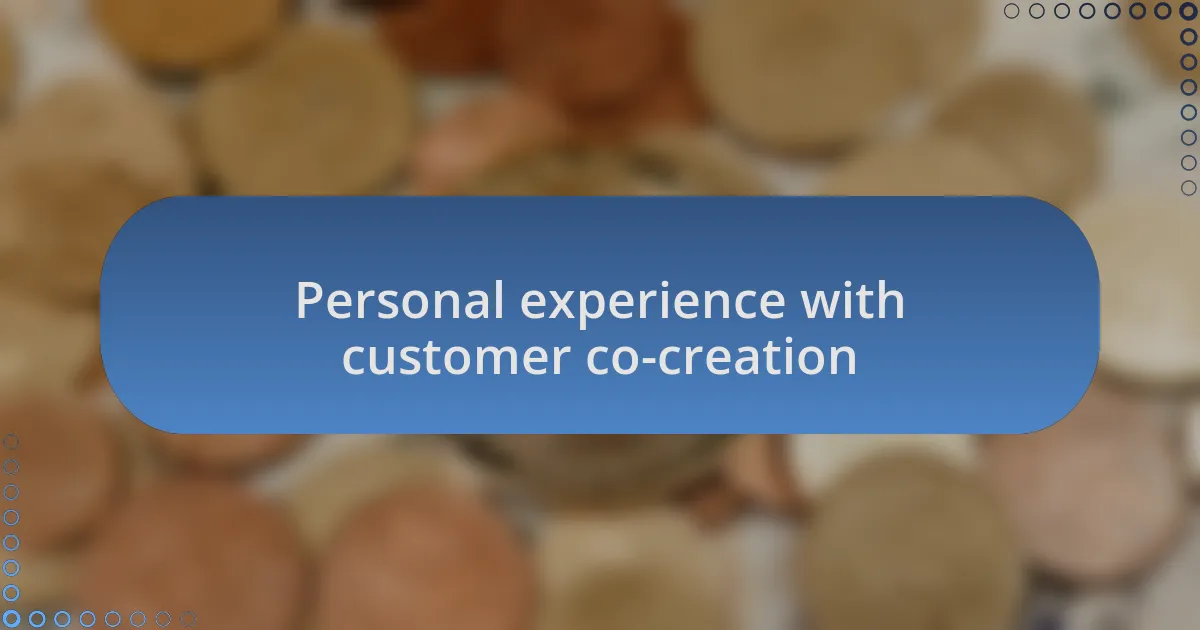Key takeaways:
- Customer co-creation transforms customers into active participants, fostering emotional connections and enhancing brand loyalty.
- Utilizing surveys, user interviews, and data analytics can effectively gather valuable customer insights for product improvement.
- Engaging customers in the development process leads to innovative solutions and a deeper understanding of user needs.
- Collaborative efforts result in features tailored to actual user demands, reinforcing community bonds between businesses and their customers.

Understanding customer co-creation
Customer co-creation fundamentally reshapes how businesses interact with their audience. It’s about inviting customers into the development process, making them feel valued, and acknowledging that their insights are as crucial as any expert’s. Have you ever felt that thrill when your feedback led to an improvement in a product you love? That’s the essence of co-creation.
When I first introduced co-creation into my projects, I was amazed at the wealth of ideas and perspectives customers brought to the table. One particular instance stands out: a client suggested a feature that I hadn’t considered, but it resonated deeply with others. This made me realize that when customers feel empowered to contribute, they also build a sense of ownership and loyalty towards the brand.
It’s fascinating to consider how the digital landscape enhances this collaboration. Social media platforms and feedback tools have made it easier than ever for customers to communicate their needs and desires. But I often wonder, are businesses truly listening? Engaging with customers in this way can lead to innovative solutions that may have otherwise gone unnoticed. Embracing co-creation not only drives product improvement but also strengthens the community around a brand, enriching the entire experience for everyone involved.

Importance of customer co-creation
Customer co-creation is essential because it transforms customers into active participants rather than passive recipients. I remember a time when I involved users in the development of a new analysis feature for my crypto platform. Their input led to a tool that was more intuitive and useful than I had initially envisioned. It was eye-opening to see how their firsthand experiences could shape a product that ultimately better served our community.
When customers collaborate with businesses, it fosters a stronger emotional connection. Think about it: how often do you feel more attached to a brand when they’ve genuinely asked for and implemented your ideas? I’ve had moments where users shared personal stories that influenced our project direction. Those narratives created deeper bonds and turned routine transactions into meaningful interactions.
Moreover, customer co-creation acts as a feedback loop for continuous improvement. In my experience, when I regularly sought input, I didn’t just receive suggestions—I gained insights that reflected industry trends and user needs. This practice keeps a brand agile, adapting quickly to change, and I’ve found that the more I involved my customers, the more innovative and effective my solutions became. Isn’t it amazing to think about how our customers can guide our journey towards success?

Overview of crypto analysis engine
A crypto analysis engine serves as a vital tool in navigating the complex world of digital currencies. It combines data from multiple sources—price movements, market trends, and transaction volumes—to create actionable insights. I recall using such an engine during a particularly volatile market period. The ability to quickly analyze real-time data helped me identify critical trends that I could otherwise have overlooked.
What truly sets a crypto analysis engine apart is its adaptability to user needs. As I’ve engaged with users, I’ve noticed they often seek features that cater to their unique trading strategies. For example, some users wanted customizable alerts for significant market shifts, and incorporating their requests transformed the way our audience interacted with the tool. Have you ever found yourself wishing for a specific feature in a tool? When those wishes are granted, the value of the service rises tremendously.
Moreover, the engine doesn’t just analyze data; it empowers users to make informed decisions based on reliable projections. I remember when a user reached out to share how our predictive analytics helped them avoid a costly investment. Hearing their success highlighted the engine’s purpose, reinforcing the idea that user experience is integral to my approach. It’s astonishing how an analysis engine can turn data into confidence, isn’t it?

Methods for gathering customer insights
Understanding how to gather customer insights is essential for crafting a meaningful crypto analysis engine. One effective method I’ve found is through surveys. After running a recent survey, I was surprised to see that users were eager to share their thoughts on what improvements could enhance their experience. It made me think—what if we actively engaged our users more frequently? Their feedback could lead to innovative features I hadn’t even considered, and that excites me.
Another approach is conducting user interviews. I once sat down with a passionate trader who revealed their distinct navigation struggles within the tool. Their personal experience resonated with me and opened my eyes to the importance of user journeys. Have you ever discovered a simple tweak that makes your life so much easier? Hearing firsthand accounts allows us to identify those pain points and refine the design to meet actual needs.
Additionally, analyzing user behavior through data analytics can shed light on patterns that aren’t immediately obvious. Once, while inspecting user flows, I noticed a significant drop-off at a specific feature. This insight led me to investigate further—was the functionality confusing? With a few adjustments based on this data, we greatly improved user retention. Isn’t it fascinating how numbers can tell a story that users sometimes hesitate to share? This blend of qualitative and quantitative insights surprisingly creates a well-rounded view of our audience’s needs.

Personal experience with customer co-creation
Customer co-creation has been a game-changer for me in enhancing our crypto analysis engine. I remember a brainstorming session where users brought in their own ideas for functionality, and it was electrifying. Hearing their enthusiasm and seeing their creativity firsthand filled me with inspiration; it was evident that they understood their trading needs far better than I could have imagined. Have you ever had that moment when a user expresses a need you didn’t even think existed? It’s a clear reminder that our customers can be our greatest allies in innovation.
In one memorable project, we invited a group of users to collaborate on the design of a new feature. The excitement in the room was palpable as each participant shared their experiences and preferences. One user, an experienced trader, suggested an alert system that focused on specific market triggers. This idea stemmed from their own frustrations, and I found it astonishing how easily one person’s pain point can morph into a transformative feature for many. It made me wonder—how many untapped ideas are out there just waiting for us to ask?
As we incorporated this collaborative feedback, I was struck by how connected I felt to our user base. When we implemented a suggestion for customizable dashboards, one customer sent me a message, thrilled about how it catered to their personal trading strategy. Their joy mirrored my own, reinforcing my belief in the power of customer co-creation. Isn’t it remarkable how creating together can foster a sense of community? That shared journey not only improves our product but also strengthens the bond between us and our users.